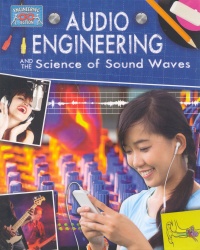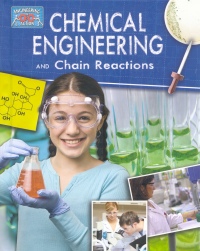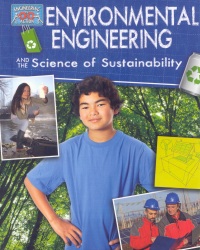| ________________
CM . . .
. Volume XX Number 26. . . .March 7, 2014 
 |
Audio Engineering and the Science of Sound Waves. (Engineering in Action).
Anne Rooney.
St. Catharines, ON: Crabtree, 2014.
32 pp., pbk., hc., pdf & html, $10.95 (pbk.) $21.56 (RLB.).
ISBN 978-0-7787-1229-9 (pbk.), ISBN 978-0-7787-1196-4 (RLB.), ISBN 978-1-4271-8947-9 (pdf), ISBN 978-1-4271-8943-1 (html).
Subject Headings:
Acoustical engineering-Juvenile literature.
Sound-Juvenile literature.
Sound waves-Juvenile literature.
Grades 5-8 / Ages 10-13.
Review by Barbara McMillan.
**** /4
|
| |
|
 |
Chemical Engineering and Chain Reactions. (Engineering in Action).
Robert Snedden.
St. Catharines, ON: Crabtree, 2014.
32 pp., pbk., hc., pdf & html, $10.95 (pbk.) $21.56 (RLB.).
ISBN 978-0-7787-1230-5 (pbk.), ISBN 978-0-7787-1197-1 (RLB.), ISBN 978-1-4271-8948-6 (pdf), ISBN 978-1-4271-8944-8 (html).
Subject Headings:
Chemical engineering-Juvenile literature.
Chemistry-Juvenile literature.
Grades 5-8 / Ages 10-13.
Review by Barbara McMillan.
**** /4
|
| |
|
 |
Environmental Engineering and the Science of Sustainability. (Engineering in Action).
Robert Snedden.
St. Catharines, ON: Crabtree, 2014.
32 pp., pbk., hc., pdf & html, $10.95 (pbk.) $21.56 (RLB.).
ISBN 978-0-7787-1231-2 (pbk.), ISBN 978-0-7787-1213-8 (RLB.), ISBN 978-1-4271-8949-3 (pdf), ISBN 978-1-4271-8945-5 (html).
Subject Headings:
Environmental engineering-Juvenile literature.
Sustainability-Juvenile literature.
Grades 5-8 / Ages 10-13.
Review by Barbara McMillan.
**** /4
|
| |
|
 |
Optical Engineering and the Science of Light. (Engineering in Action).
Anne Rooney.
St. Catharines, ON: Crabtree, 2014.
32 pp., pbk., hc., pdf & html, $10.95 (pbk.) $21.56 (RLB.).
ISBN 978-0-7787-1232-9 (pbk.), ISBN 978-0-7787-1228-2 (RLB.), ISBN 978-1-4271-8950-9 (pdf), ISBN 978-1-4271-8946-2 (html).
Subject Headings:
Optical engineering-Juvenile literature.
Optics-Juvenile literature.
Grades 5-8 / Ages 10-13.
Review by Barbara McMillan.
**** /4
|
| |
|

excerpt:
Audio engineers work in the music and film industries, in radio and television broadcasting, and at live venues such as concert halls. They can work on live and recorded sound, doing pre- and post-production tasks. There are also opportunities in the design of audio equipment, and restoring and digitizing old analog recordings. (From Audio Engineering.)
Chemical engineers operate on a large scale, taking the reactions that chemists have discovered and making them work in the real world rather than in laboratories. While the chemist measures materials in grams or ounces, the chemical engineer may measure them in tons. Rather than using laboratory test tubes, the chemical engineer is responsible for designing and operating industrial plants with huge steel containers and miles of piping. (From Chemical Engineering.)
Environmental engineering is the practice of solving problems in a way that improves the quality of human life, while protecting the environment from the effects of human activities. Engineers must deal with problems relating to the environment at local and global levels. Among other things, environmental engineers find ways to keep water clean and control and manage hazardous waste. They look for energy sources that won’t cause damaging changes, such as global warming, and they are involved in protecting wildlife. (From Environmental Engineering.)
Optics is the science of light. Optical engineers work with many technologies to use and control light. Over the last five centuries, optical engineering has given us telescopes, glasses, photography, film, broadband networks, and TV. It is a world-changing area of work. (From Optical Engineering)
Anne Rooney and Robert Snedden, the authors of four new books in Crabtree’s “Engineering in Action” series, have taken the science trade book for youth in a new direction. Their emphasis is knowing science for a purpose, and this purpose extends beyond success in school science. Each author links an understanding of sound energy and light energy or chemical reactions and environmental sustainability to exciting careers in these fields. Given the current focus on STEM (science, technology, engineering and mathematics) education in many jurisdictions, the “Engineering in Action” series will be a timely addition to school library collections.
Kathy Middleton, the project coordinator, chose a format and a layout for the series that include a background of blueprint paper onto which stock photographic images and diagrams are randomly placed along with the printed text on pale violet and what appear to be handwritten notes on canary yellow sticky notes and yellow-ruled notebook paper. Each 32-page book contains a table of contents, glossary, index, and a “Learning More” page with short lists of relevant books and websites and museums to visit. Within pages 4 through 29, Rooney and Snedden tell readers about the field they are addressing, describe what the engineers associated with each field have done in the past and are currently working upon, and illustrate the eight-step design process that engineers use to solve a problem by presenting a detailed example over eight pages. This is followed by a section titled “Design Challenge” where readers are encouraged to create a soundtrack (audio engineer), make a fire extinguisher (chemical engineer), design a desalination project (environmental engineer), and make a periscope (optical engineer) using the design process.
Embedded in the text of each book, Rooney and Snedden have included descriptions of interesting science research and the engineering applications. In Optical Engineering, Rooney writes about surgery that uses laparoscopic cameras providing surgeons with wide-angle views and high-resolution images, and the engineers that are developing ways to best display these images for surgeons in operating theatres. She also mentions a new technique, named orthokeratology, that uses compression contact lenses, worn during sleep, that reshape the eye so that eye glasses or contact lenses will no longer be necessary. As exciting is the development of light sensitive materials using nanotechnology. Rooney shares two ideas for this new material. One is a solar sail to move spacecraft. The other is the creation of a tent that collects the sun’s light energy and uses this energy to power the equipment inside the tent.
In Environmental Engineering, Snedden tells readers about testing off-shore floating wind turbines and wind turbines suspended in the air by helium balloons, harnessing wave power to supply electricity in Scotland, the use of methane gas generated in landfills to produce electricity, the development of portable desalination devices, and thinking about “spray ships” that could cool the planet by blasting ocean water into the air. These are exciting endeavors that often sound more like science fiction than design solutions and prototypes informed by living scientists and engineers. Such creative, future thinking, however, may be all that is necessary to increase interest in science and engineering and perhaps inspire some Middle Years students to consider a career in science or engineering.
Highly Recommended.
Barbara McMillan is a teacher educator and a professor of science education in the Faculty of Education, the University of Manitoba.

To comment
on this title or this review, send mail to cm@umanitoba.ca.
Copyright © the Manitoba Library Association. Reproduction for personal
use is permitted only if this copyright notice is maintained. Any
other reproduction is prohibited without permission.
NEXT REVIEW |
TABLE OF CONTENTS FOR THIS ISSUE
- March 7, 2014.
AUTHORS |
TITLES |
MEDIA REVIEWS |
PROFILES |
BACK ISSUES |
SEARCH |
CMARCHIVE |
HOME |



